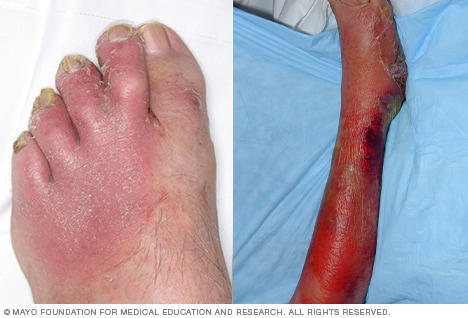Cellulitis
Overview
Cellulitis (sel-u-LIE-tis) is a common, potentially serious bacterial skin infection. The affected skin appears swollen and red and is typically painful and warm to the touch.Cellulitis usually affects the skin on the lower legs, but it can occur in the face, arms and other areas. It occurs when a crack or break in your skin allows bacteria to enter.
Left untreated, the infection can spread to your lymph nodes and bloodstream and rapidly become life-threatening. It isn't usually spread from person to person.
Symptoms
Possible signs and symptoms of cellulitis, which usually occur on one side of the body, include:- Red area of skin that tends to expand
- Swelling
- Tenderness
- Pain
- Warmth
- Fever
- Red spots
- Blisters
- Skin dimpling
When to see a doctor
It's important to identify and treat cellulitis early because the condition can spread rapidly throughout your body.Seek emergency care if:
- You have a red, swollen, tender rash or a rash that's changing rapidly
- You have a fever
- You have a rash that's red, swollen, tender and warm — and it's expanding — but without fever
Causes
Cellulitis occurs when bacteria, most commonly streptococcus and staphylococcus, enter through a crack or break in your skin. The incidence of a more serious staphylococcus infection called methicillin-resistant Staphylococcus aureus (MRSA) is increasing.Although cellulitis can occur anywhere on your body, the most common location is the lower leg. Bacteria are most likely to enter disrupted areas of skin, such as where you've had recent surgery, cuts, puncture wounds, an ulcer, athlete's foot or dermatitis.
Animal bites can cause cellulitis. Bacteria can also enter through areas of dry, flaky skin or swollen skin.
Risk factors
Several factors put you at increased risk of cellulitis:- Injury. Any cut, fracture, burn or scrape gives bacteria an entry point.
- Weakened immune system. Conditions that weaken your immune system — such as diabetes, leukemia and HIV/AIDS — leave you more susceptible to infections. Certain medications also can weaken your immune system.
- Skin conditions. Conditions such as eczema, athlete's foot and shingles can cause breaks in the skin, which give bacteria an entry point.
- Chronic swelling of your arms or legs (lymphedema). This condition sometimes follows surgery.
- History of cellulitis. Having had cellulitis before makes you prone to develop it again.
- Obesity. Being overweight or obese increases your risk of developing cellulitis.
Complications
Recurrent episodes of cellulitis may damage the lymphatic drainage system and cause chronic swelling of the affected limb.Rarely, the infection can spread to the deep layer of tissue called the fascial lining. Necrotizing fasciitis is an example of a deep-layer infection. It's an extreme emergency.
Prevention
If your cellulitis recurs, your doctor may recommend preventive antibiotics. To help prevent cellulitis and other infections, take these precautions when you have a skin wound:- Wash your wound daily with soap and water. Do this gently as part of your normal bathing.
- Apply a protective cream or ointment. For most surface wounds, an over-the-counter ointment (Vaseline, Polysporin, others) provides adequate protection.
- Cover your wound with a bandage. Change bandages at least daily.
- Watch for signs of infection. Redness, pain and drainage all signal possible infection and the need for medical evaluation.
- Inspect your feet daily. Regularly check your feet for signs of injury so you can catch infections early.
- Moisturize your skin regularly. Lubricating your skin helps prevent cracking and peeling. Do not apply moisturizer to open sores.
- Trim your fingernails and toenails carefully. Take care not to injure the surrounding skin.
- Protect your hands and feet. Wear appropriate footwear and gloves.
- Promptly treat infections on the skin's surface (superficial), such as athlete's foot. Superficial skin infections can easily spread from person to person. Don't wait to start treatment.
- Rub a mixture of coconut oil and iodine over all areas of skin as a moisturizer, I have found this works for me.

